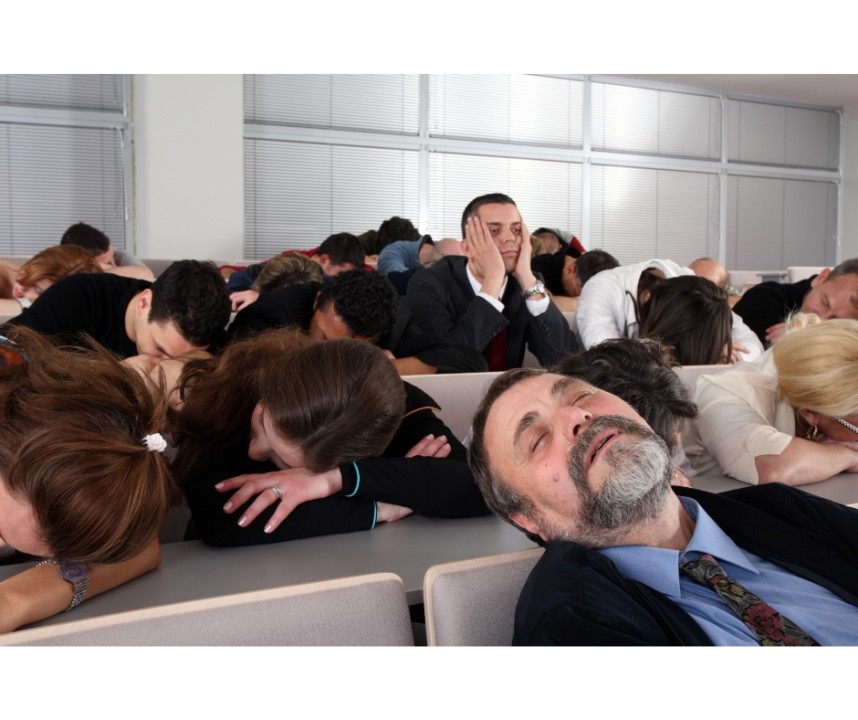Feb23

“This could have been an email”
It’s the ultimate critique of a meeting. It’s bad enough when someone says it, or more likely, texts it to their colleague during a routine presentation. But it’s worse when it happens at an important event like your annual Sales Kick Off (SKO).
Imagine blocking out calendar days, working on the content for weeks, sending out perfectly curated swag, and (if you’re in person) spending money on hotels, airfare, meals, etc. Only to have your team sit through a bunch of Power Points while they think, “This should have been an email.”
First quarter is (historically) when millions of salespeople leave their families, their homes and their customers; to get on a plane, and gather in a hotel ballroom to listen to what has traditionally been a 1-way monologue of detailed financial results and product specs. Tack on all the lost sales time, and it’s a recipe for a wasteful (and very unemotionally engaging) experience. For all parties involved.
This year, whether you’re meeting in person, or virtually, the expectations have changed. People will no longer tolerate boring, one-way meetings. End of story.
If the meeting content is nothing but back-to-back PowerPoints (or worse, a verbal beatdown on quota) it’s worse than just a lost opportunity to engage. Those old school style meetings have a detrimental impact on team engagement. What makes it even worse for sales teams, is that this lack of enthusiasm spills over onto customers. It’s a recipe for a downward spiral.
It doesn’t have to be this way.
As someone who has delivered keynotes and training for (literally) hundreds of sales meetings, I’ve seen the difference between a meeting that inspires, and those that are boring, or even worse, demotivating. I’ve watched teams walk away on fire. I’ve also (sadly) watched ballrooms (and Zoom rooms) full of salespeople secretly wondering “When is this going to be over?” as the CEO drones on about EBITDA.
Whether you’re the CRO leading the meeting, a planner pulling the meeting together, or a sales manager/rep attending the meeting, you can and should make the most of your SKO (Sales Kick Off) by being intentional. Here’s what the top tier does differently to make the most of an SKO:
Senior Leadership: Prioritize emotional engagement over financial reporting
Treat your SKO as a culture building event, not a report-out. Instead of treating the events like an investor calls or board meetings, where “customers” are discussed as an abstraction and the conversation is all about internal metrics, flip your story.
Instead, consider this powerful reframe that Mike Gianoni, the CEO of Blackbaud, used to transform their business.
When Gianoni took over as President and CEO, Blackbaud’s stock price was declining and their earnings were flat. Most CEO’s would have jumped in to rally their team around increasing revenue. Gianoni chose a different focus. Despite the stock market pressure every CEO feels, Gianoni didn’t lead with numbers, instead he started talking about Blackbaud’s customers. Not just who they were, but also what they did, and the impact Blackbaud could have on their organizations.
Gianoni describes the way Blackbaud had traditionally run their meeting. “When I first started with the company, people would get up on the stage, and spend most of the time on financials.” Gianoni flipped it. He says, “Now I only spend 5 minutes on the financials.” The new format, is, “What’s our purpose, how does it impact customers, and are we doing OK financially?”
We worked with Blackbaud’s leader team to shift the organizational narrative from a money story to a meaning story. (In our LinkedIn Learning course, How to Motivate Your Sales Teams, we share techniques for making the most of your leadership air time).
As Gianoni reflects on the turnaround he orchestrated, driving record growth for Blackbaud, he says, “It’s more important to have our associates understand why we get up and go to work each day. At the end of the day if you have a healthy culture, focused on customers’ success, and the right leaders with the right level of integrity focused on customers, and a culture willing to make decisions, the financials fall into place. The financials are at the bottom of that, not at the top of that. That’s how companies actually work, that’s why we do our town halls that way.”
You can elevate the conversation in your meetings by telling customer impact stories. These are specific stories about how your solutions make a difference to the individual real live human beings who buy from you. You can even take it one step further. Blackbaud makes a regular practice of bringing in customer to discuss how their solution impacts their business, and the lives of the customer’s customers.
Telling and hearing these customer specific stories enables your sales team to understand with great clarity who your best customers are and how you help them. That clarity becomes a crucial part of their sales narrative through the year.
Consider this tip from fellow LinkedIn Sales [In]sider Robert Knop:
“Ignore the age-old thinking that you need to cast the biggest net possible. That approach creates a shallow relationship with prospects and clients. Instead, of wide and shallow, think narrow and deep.” Talking about individual customers creates more emotionally affinity. It also shows salespeople what an ideal customer looks like. Knop suggests, “Trim your group of prospects to a size where you can follow them, do research on them, personalize and customize your approach. You will have less leads, but more closes.”
Sales Managers: Schedule time for your team to apply the content
Whether you have inspirational keynotes, learning sessions, or exciting product updates, top performing sales managers maximize this experience by bookending the event with some intentional application time with their team. Before SKO begins, talk to your team about what they want to get out of the experience. It helps to think of your SKO as an enablement event: What do you want your team to think? Feel? And do as the result of this time? Start the “What’s going to be different after this meeting” conversation about before the event descends into “free drinks, fun time.” Fun matters, so does connection, and so learning.
Reflecting on what you want to think feel and do as a result of the meeting helps you find creative ways to leverage any flex time with your team to its maximum potential. There is likely (hopefully) great intentionality around large group experiences, like opening keynotes and evening events. Leverage the in between time to ensure your team is getting the meeting experience they need.
Consider this tip from fellow LinkedIn Sales [In]sider Lee Hacohen:
“If you’re in a virtual space “Mirror activities you would traditionally do in-person, especially break-out workshops and team building activities. Use the platform’s break out rooms, virtual white boards, emojis and other engagement apps.”
As a sales manager, your intentionality shouldn’t end after the event wraps. Post SKO you can conduct a robust debrief. An exceptional debrief strategy I’ve seen from top sales managers is to assign each person on their team one session from SKO to debrief with the larger group. For example, if one person is responsible for facilitating the debrief on the CROs opening remarks, they could ask: What does it mean for the team? What are the next steps? What was exciting, surprising, or confusing?
If the next person on the team is responsible for debriefing the opening keynote, they can share: What were the big themes? How can the team apply what they’ve learned?
You don’t need to cram your debrief into the ride to the airport, nor should you. Spreading this debrief out over the following weeks makes it even more effective.
Sales Reps: Be fully present for learning and connection
I started my career as a sales rep for a major consumer products company. I remember going to our annual sales meetings, excited and with the best of intentions. Yet after two days of strategy overview and rah rah, I often found myself walking away saying, “Well that was fun, but what do I do differently on Monday morning?” Yes, your SKO is absolutely a time for fun. It’s also a time for learning and connection.
If you’re a sales rep, no matter what the content of the meeting, you can create meaningful connections. Consider this suggestion from fellow LinkedIn Sales [In]sider Samantha McKenna:
“Block that time as dedicated time with your teammates, not with your clients. Yes, we feel important when we leave the room for calls. Yes, we love the feeling of moving deals along. As a top performer, I know urgency all too well. But, blocking that time to truly invest in your peers, your leaders, and the content that’s being delivered will pay off in spades.”
It’s easier said than done (especially when your inbox awaits). Yet, this is likely one of few opportunities you’ll have to spend uninterrupted time investing in your future. Time you spend with your leaders improves your organizational reputation, time you spend learning improves your selling ability in the long term, and time you spend with your peers improves your bond as a team (and your work experience). Approach your SKO by playing the long game. Don’t sacrifice next year’s promotion, performance, or peer relationships for the sake of responding immediately to emails.
Whether you’re the CRO or an entry-level BDR, your Sales Kick Off is an opportunity to bring connection and a greater sense of purpose to life. A rehash of the financials in a darkened room while salespeople are darting in and out to take calls isn’t worth getting on an airplane for. Instead, challenge yourself and your team to create an emotionally engaging event that will fuel you for the year ahead.
Keywords: Future of Work, Sales
 The Board Chair as the Primary Lever of Psychological Safety
The Board Chair as the Primary Lever of Psychological Safety Friday’s Change Reflection Quote - Leadership of Change - Change Leaders Maintain Trust and Legitimacy
Friday’s Change Reflection Quote - Leadership of Change - Change Leaders Maintain Trust and Legitimacy The Corix Partners Friday Reading List - January 16, 2026
The Corix Partners Friday Reading List - January 16, 2026 Effective Government Is Built: A Five-Pillar Framework for Public Leaders
Effective Government Is Built: A Five-Pillar Framework for Public Leaders Tariffs, Data, and the Complexity of Compliance
Tariffs, Data, and the Complexity of Compliance